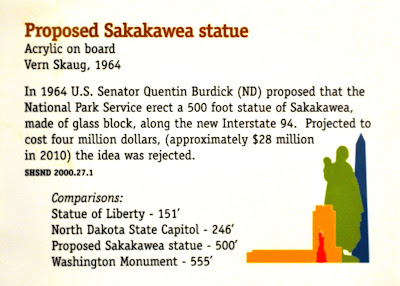"Sacagawea," by Michael Haynes.
Sacagawea, Sakakawea, Sacajawea
Imagery About Historical Figure
By Dakota Wind
GREAT PLAINS - Some time back I posted an explanation about the name of the young native mother who accompanied the Corps of Discovery from Knife River to the west coast. What is her name? How is it really pronounced? These are a couple of questions that people pose as though knowing her name means knowing who she was.
Of interest to some people is how she looked or dressed, even what kind of cradle board she put Pomp in, or if she just carried her baby in a sling on her back.
Artist Andrew Knudson painted this scene (above) of the Corps of Discovery entering Black Cat's Village (present-day Stanton, ND), a Mandan Indian village.
Vern Erickson created this scene (above) he called "Sacagawea, Lewis, Clark." Sacagawea is almost always portrayed with her baby boy Pomp, an American icon as inseparable as macaroni and cheese.
H. Charles McBarron painted this wonderful painting (above) titled "Lewis and Clark at Mandan Village, 1804." A beautiful picture with a wonderful attention to detail on the Mandan Indians clothes and Sacagawea's clothes. The State Historical Society of North Dakota has a commentary card accompanying this painting, drawing viewers' attention to the portrayal of Sacagawea, a view from behind and without her husband and without her baby. My commentary is this: Why is Sacagawea in a Mandan village?
"Corps of Discovery at a Knife River Village," by Vernon W. Erickson (above). There's very few Hidatsa Indians pictured in this painting, and most of those are painted as an afterthought or as ghosts. The only real detail is in the Corps of Discovery, a couple of Hidatsa, Charboneau, and Sacagawea. Sacagawea might take direct center stage in this painting, but her likeness was rendered closer to that of a twelve year old girl or else a ninety year old grandmother. York, Captain William Clark's slave since they both were children, is portrayed wearing what appears to be a dress uniform.
Mink (Hannah Levings) of the Arikara, Hidatsa, Mandan Nation posed for Orin G. Libby as one of the most famous American Indian women, Sacagawea.
During the centennial celebration of the Corps of Discovery, the State of North Dakota wanted to honor Sacagawea. A few paintings were commissioned and sold to raise money for a Sacagawea statue. A young native woman and her baby were selected to serve as the model for the statue.
The Sakakawea statue (above) as it stood on the Bismarck capital grounds in 1906.
At one point, the state of North Dakota had even considered erecting a massive statue in the likeness of Sacagawea along Interstate 94.
Personally, I think it should have been built looking east towards Washington DC.
Sacagawea, Sakakawea, Sacajawea
Imagery About Historical Figure
By Dakota Wind
GREAT PLAINS - Some time back I posted an explanation about the name of the young native mother who accompanied the Corps of Discovery from Knife River to the west coast. What is her name? How is it really pronounced? These are a couple of questions that people pose as though knowing her name means knowing who she was.
Of interest to some people is how she looked or dressed, even what kind of cradle board she put Pomp in, or if she just carried her baby in a sling on her back.
Artist Andrew Knudson painted this scene (above) of the Corps of Discovery entering Black Cat's Village (present-day Stanton, ND), a Mandan Indian village.















